7 Tips to Lessen your Dogs Anxiety During Fireworks
Do Fireworks panic your puppy? Advice to reduce the fourth of July stress in dogs. As our fellow Pawtriots look forward to the July 4th festivities, anxiety levels rise. Surprisingly, not all dogs are actually afraid of fireworks. This fourth […]
7 Tips to Lessen your Dogs Anxiety During Fireworks Read Post











